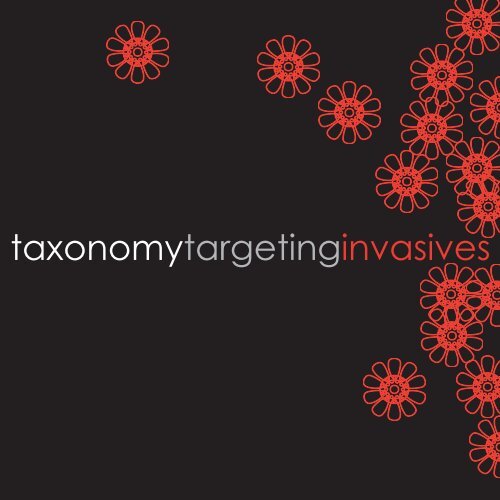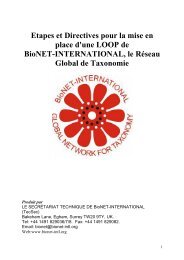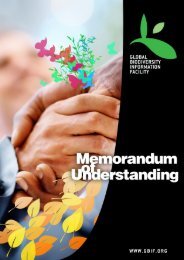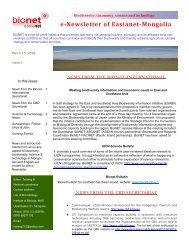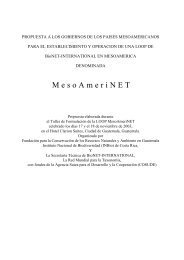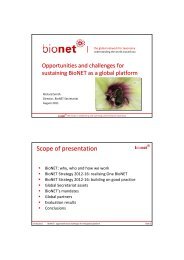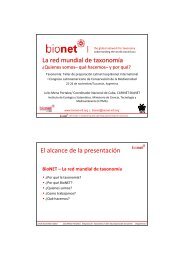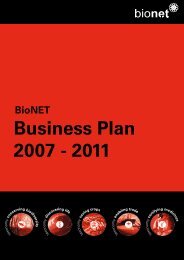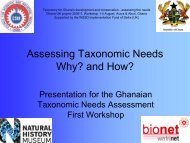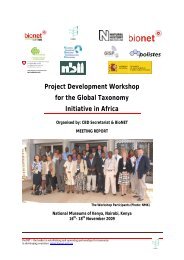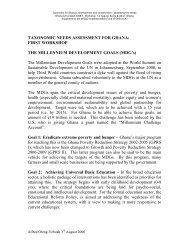Bio cover - BioNET
Bio cover - BioNET
Bio cover - BioNET
You also want an ePaper? Increase the reach of your titles
YUMPU automatically turns print PDFs into web optimized ePapers that Google loves.
Correct identification of fungussaves wheat export marketcase study8The fungus Tilletia indica causesthe disease Karnal bunt in wheat.In 1996 and 1997, much of the$5-billion/year U.S. wheat exportmarket was threatened by thesupposed dis<strong>cover</strong>y of the fungusin wheat crops in Arizona and asmall part of California. About onethird of countries that might buywheat from the United Stateswould not buy Karnal-bunt-infectedwheat. During the U.S. nationalKarnal bunt survey of 1996,T. indica-like fungal spores(teliospores) were found in wheatgrain washes from the southeasternUnited States. However, thesurvey could not find directevidence of bunted i.e. blackenedand foul-smelling, wheat seeds.Ryegrass seed infected with asimilar fungus is sometimesharvested along with the wheat.Initially, available tests incorrectlyidentified this fungus as Karnalbunt. As a result, in 1996-97,restrictions were placed on themovement of suspect wheat fromAlabama, Georgia, Florida, andTennessee.SectorsAgriculture; invasive alien species, tradeLocationUnited States; all wheat growing areasworldwideMethodsWhile the wheat grain wash samples in thesoutheastern United States, were testingpositive for the Karnal bunt fungus using thethen-available molecular test, because nobunted wheat kernels were found an incorrectidentification was suspected by taxonomists.After close taxonomic re-examination of thebunt fungi family using light and scanningelectron microscopy of the spores, it wasdetermined that the Tilletia species on theryegrass was an unnamed species new toscience. With these techniques, it wasdetermined that, with experience, visualcharacteristics could be used to tell the twofungi apart.Outcomes and ImpactsThe new techniques quickly showed that 100percent of each of the wheat samples collectedfrom southeastern farms in 1996 werecontaminated with the new fungus (named T.walkeri) and not Karnal bunt. As a result, inMarch 1997, restrictions on the movement ofthe suspect wheat were lifted. Federal plantquarantine officials now use the new techniqueas a first cut, to decide if possible quarantineactions are needed.If Karnal bunt had been incorrectly confirmed inthe southeastern US wheat crop, it would haveindicated that Karnal bunt was widespread inthe US and that all wheat produced in the USwas potentially infected. This would havethreatened the entire US $5 billion exportmarket, with disastrous consequences.LessonsTaxonomic expertise allowed for the distinctionbetween the different fungal species. Thecorrect identification of a new fungus led to thelifting of the ban on movement of the wheatcrops from the southeastern United States andprevented the wholesale rejection of all wheatexport produce from the US. What could havebeen a trade and agricultural disaster wasavoided.References: 1. http://www.ars.usda.gov/is/AR/archive/mar99/bunt0399.htm 2. Castlebury, L.A. and Carris, L.M. Tilletiawalkeri, a new species on Lolium multiflorum and L. perenne.Mycologia 91: 121-127. 1999.Contributed by: Lisa. A. Castlebury (lisa@nt.ars-grin.gov) andMary. E. Palm (maryp@nt.ars-grin.gov): USDA-ARSSystematic Botany and Mycology Laboratory, Bldg. 011A,10300 Baltimore Ave., Beltsville, MD 20705; phone (301) 504-5364 or (301) 504-5327, fax (301) 504-5810.taxonomytargetinginvasives
Taxonomic review saves Buttercup Squashmarket from pest fearscase study31Each year some consignments ofbuttercup squash from NewZealand, worth about US$600,000per year to growers, were beingdestroyed or reshipped by SouthKorea because of a fungus thatwas believed to threaten theirdomestic rice crop. Potatoes fromUSA have also been destroyedwhen the same fungus wasdetected. The Korean NationalPlant Quarantine Service had listedVerticillium tenerum in theirControlled Pathogen List as aCategory 2 organism - “commodityallowed into country with propertreatment, or otherwisecontaminated material to bedestroyed or otherwise disposed.”New Zealand authorities had alsolisted this fungus as a quarantinepest on Pinus seed imports intoNew Zealand.SectorsAgriculture; trade; pests; invasive alien species.LocationNew Zealand; South Korea.MethodsA thorough literature review and consultationwith colleagues on the naming, biology,distribution, and pathogenicity of V. tenerumwas undertaken to convince Korean authoritiesthat this fungus is neither a parasite of rice nora legitimate quarantine pest.Outcomes and ImpactsThere has been extensive confusion over thenaming of the fungus known as V. tenerum anddebate over whether or not it is the anamorphof Nectria inventa. The correct name for thefungus is V. luteo-album, and it is not related toN. inventa. Molecular and morphologicalstudies (communicated by Dr W. Gams,Centraalbureau voor Schimmelcultures,Netherlands) have shown that V. luteo-albumpossibly belongs in a separate genus from thewell-known plant pathogenic species, V.albo-atrum and V. dahliae. V. luteo-album is acosmopolitan saprobe with no damaging effectson rice.Both the Korean and New Zealand authoritieshave now removed V. luteo-album from theirpest lists after accepting the results of researchthat showed it was not a threat. New Zealandbuttercup squash growers now have anassured market and Koreans have access tooff-season, high quality squash.LessonsA thorough taxonomy review of Verticilliumluteo-album provided the evidence thatquarantine authorities required to remove anon-tariff trade barrier.Reference: McKenzie, E.H.C. 2003: Verticillium luteo-album(syn. V. tenerum), <strong>Bio</strong>logy, Distribution, Pathogenicity. LandcareResearch Contract Report: LC0304/022.Contributed by: Eric H.C. McKenzie, email:mckenziee@LandcareResearch.co.nz. Landcare Research,Private Bag 92170, Auckland, New Zealand; phone +64 9 5744173, fax +64 9 574 4101.taxonomytargetinginvasives
Keeping the weevils from Bangladesh’s cottoncase study33Cotton Boll Weevil, Anthonomousgrandis, is a notorious pest ofcotton in the USA where it persistsdespite an intensive, 20-yeareradication programme. It is notknown to occur in Bangladesh, acountry that imports cotton from anumber of countries, including theUSA, to meet demand from itseconomically important textileindustry. Standard phytosanitaryprocedure requires importedcotton to be fumigated for 72 hourson board ships at the port of entryto protect Bangladesh’s cottonproduction from alien pest species,especially Cotton Boll Weevil. In arecent incident, Bangladesh TextileMills Association (cottonimporters) and the US Ambassadorargued that this fumigationtreatment is unnecessary.Bangladesh governmentauthorities had to decide whetherto contest the US position.SectorsAgriculture; trade; pests; invasive alien species.LocationBangladesh.MethodsThe Ministry of Agriculture, Bangladesh, invitedseveral expert entomologists (taxonomists) toadvise on the appropriate response to USgovernment assertions that: (a) fumigationrequirements are unnecessary from a scientificperspective, extremely costly and not required;(b) prior to shipment, cotton fibre is inspectedby the U.S. Department of Agriculture andcertified as being free of Boll Weevil; and (c)fumigation only serves to increase the price ofU.S. cotton, thereby damaging thecompetitiveness of garment and textile exportsfrom Bangladesh.The taxonomists confirmed that the Cotton BollWeevil is not found in Bangladesh. Importantly,they advised that Boll Weevils can enter adormant state for 10-11 months (anoverwintering survival strategy). It is alsopossible that their eggs could survive in aconsignment of cotton in dormant adult weevils.OutcomeThe taxonomists recommended that:(a) Fumigation at the port of entry must becontinued to prevent invasion of anyunknown pest including Cotton Boll Weevil.(b) Experts from member countries of theIPPC and APPPC should make a definitiveruling (fumigation is mandatory in othercotton importing countries of the region).LessonsThe involvement of scientists (taxonomists) isvital for phytosanitary and quarantine services,prevention of invasions by alien pest speciesand protecting a country from accusations ofunfair practice by a trading partner. Withoutlocally available taxonomic expertise, cottonproduction in Bangladesh would have been putat risk from cotton imports containing CottonBoll Weevil in dormant or egg form. Lostcotton production and pest eradication costswould have had significant economic and socialconsequences, as in other countries that arehighly dependent on agriculture. Maintaininglocally accessible taxonomic expertise is ahighly cost-effective approach to protectingagricultural and trade interests.References: Bangladesh Gazette, 1989. Destructive insectsand pests rules, 1966 (Plant Quarantine) amended up to July1989.Pierce, J B, 1998. Cotton Boll Weevil <strong>Bio</strong>logy, Guide A-232,Agricultural Science Center at Artesia, New Mexico StateUniversity.Contributed by: Professor Badrul Amin Bhuiya, Chairman,<strong>Bio</strong>diversity Research Group of Bangladesh and InterimNational Coordinator, <strong>Bio</strong>NET-SACNET Bangladesh,Department of Zoology University of Chittagong, Chittagong4331, BANGLADESH.e: babhuiya@ctgu.edu | babhuiya@hotmail.comw: www.brgb.orgtaxonomytargetinginvasives
Symbiotic fungus provides early warningand minimises forestry losescase study34In 1994, while conducting researchon another forestry pest, thedisintegrated body parts of ametallic bluish-black wasp werefound under the bark of a 40 yearold Pinus radiata tree which hadbeen felled and then rejected in aplantation outside Cape Town.Further examination revealedround exit holes similar to thosedescribed in the literature for thewoodwasp Sirex noctilio, a forestrypest previously unknown in SouthAfrica. S. noctilio originates inEurasia and North Africa where itattacks stressed conifer species. Ithas since spread to plantations inother parts of the world, killing upto 70% of trees.SectorForestry; pests; invasive alien speciesLocationSouth AfricaMethodsIt was not possible to identify the wasp from itsremains, so a sample of the wood was sent tothe mycology division of the National Collectionof Insects in Pretoria where it was cultured totest for the presence of a symbiotic fungus(Amylostereum areolatum). Femalewoodwasps inject trees with A. areolatum alongwith a mucus just prior to laying their eggs.Once the larvae hatch they feed on the funguswithin the wood, making a U-turn when the lessnutritious heart-wood is reached, andeventually pupate in the wood below the bark,before emerging as adult woodwasps afterabout a year. The presence of this symbioticfungus would indirectly confirm the presence ofthe woodwasp.Outcomes and impactsAnalysis confirmed the presence of A.areolatum and hence the woodwasp. Theconfirmation came a year before the first waspspecimen was captured. Early warning of thewoodwaspís presence allowed an immediatestart to be made on the importation ofbiological control agents that had workedsuccessfully in Australia and New Zealand.Within a year, the key parasitic nematodeDeladenus siricidicola, had been introduced,followed a year later by other biological controlagents: Hymenopterous parasitoid Ibalialeucospoides and then by Megarhyssa nortoni.Between 1994 and 2001 the woodwasp spread380km along the west and east coasts butsuccessful biological control meant that at nopoint were more than 3% of the trees lost.LessonsThe speed with which biological control wasimplemented after the indirect identification ofthe woodwasp was directly responsible for theminimal losses experienced by the forestryindustry of South Africa. Taxonomic expertisewas essential for the early detection of theinvasive pest and for design of the biocontrolprogramme that contained the threat.References: 1. Baxter, A.P., Rong, I.H. & Schutte, et a.l. 1995.Amylostereum areolatum (Aphyllophorales: Stereaceae) inSouth Africa. South African Journal of Botany 61 (6): 352-354.2. Bedding,R.A. 1993. <strong>Bio</strong>logical control of Sirex noctilio usingthe nematode Deladenus siricidicola. In: Bedding, R.A.,Akhurst, R.J. & Kaya, H. (Eds) Nematodes and the <strong>Bio</strong>logicalControl of Insect Pests. 11 - 20. CSIRO, Australia. 3. Neumann,F.G., Morey, J.L. & McKimm, R.J. 1987. The Sirex wasp inVictoria. Department of Conservation, Forests and Lands.Bulletin No. 29, 41pp. 4. Tribe, G.D. 1995. The woodwaspSirex noctilio Fabricius (Hymenoptera: Siricidae), a pest ofPinus species, now established in South Africa. AfricanEntomology 3: 215-217.Contributed by: G. D. Tribe, Plant Protection ResearchInstitute, Private Bag X5017, Stellenbosch 7599, South Africa.e: vredgt@plant3.agric.zataxonomytargetinginvasives
<strong>Bio</strong>NET-INTERNATIONAL: the GlobalNetwork for Taxonomy, was established in1993 and has a vision of A world in whichtaxonomic expertise, resources andinformation are rapidly and locally accessiblein forms appropriate for meeting conservation,agriculture, trade and other sustainabledevelopment needs. Focused on capacitybuilding for developing countries, <strong>Bio</strong>NETactivities are particularly targeted onsupporting the Global Taxonomy Initiative ofthe Convention on <strong>Bio</strong>logical Diversity and thetaxonomic capacity needs of parties to otherinternational agreements.<strong>Bio</strong>NET is comprised of a secretariat and agrowing, government-endorsed, institutionaland human network organised into tensubregional LOOPs, each independentlymanaged by its member countries andpartners.At the global and regional levels, <strong>Bio</strong>NEThelps coordinate and engage taxonomists,users of taxonomy and technology providers inthe capacity building partnerships needed toapply taxonomy to priority issues such asinvasive alien species.Why Taxonomy Matters is a series of shortcase studies that provide varied examples ofthe critical contributions of taxonomy tosociety. Further contributions are welcome.See: www.bionet-intl.org/case_studies.whytaxonomy mattersContact: bionet@bionet-intl.orgWebsite: www.bionet-intl.orgGISP, the Global Invasive SpeciesProgramme, was established in 1997 toaddress global threats caused by invasivealien species (IAS), and to provide support tothe implementation of Article 8(h) of theConvention on <strong>Bio</strong>logical Diversity (CBD).Our founding core partners during GISP PhaseI were the Scientific Committee on Problems ofthe Environment (SCOPE), CAB International(CABI) and the World Conservation Union(IUCN). GISP Phase I, managed fromheadquarters in the USA and partly funded bythe United Nations Environment Programme(UNEP), largely relied on voluntarycontributions from a substantial group ofscientists, lawyers, and managers from allparts of the world.Phase II, now headquartered in South Africa,is a contributory Partnership Network oforganizations and programmes from aroundthe world with an interest in IAS issues.Building on this partnership approach, GISP isimproving cooperation with our existing andnew partners in the IAS world, to maximise theeffectiveness of joint programmes and promotethe sharing of best-practice information. GISPis an enabling body, focusing on effectiveinformation exchange, networking, capacitybuilding and practical tools for developingcountries. In this light, GISP works closely with<strong>Bio</strong>NET, the IUCN Invasive Species SpecialistGroup and others to make tools andinformation available for users throughout theworld.Contact: gisp@nbi.ac.za or barnard@nbi.ac.zaWebsite: www.gisp.orgThe Invasive Species Specialist Group(ISSG) is a specialist group of the SpeciesSurvival Commission (SSC) of the WorldConservation Union (IUCN). ISSG wasestablished in 1993 and currently has around160 voluntary members from over 40countries, chaired by Prof Mick Clout (NewZealand). The mission of ISSG is: “to reducethreats to natural ecosystems and the nativespecies they contain, by increasing awarenessof alien invasions and of ways to prevent,control or eradicate them”. ISSG's scope isglobal.The Global Invasive Species Database, isfreely available online. Records includeinformation on the ecology, impacts,distribution and pathways of invasive alienspecies, and most importantly, information onmanagement methods as well as contactdetails of experts that can offer further advice(www.issg.org/database).Aliens is the bi-annual newsletter of theInvasive Species Specialist Group (ISSG).Aliens-L is a listserver that allows users tofreely seek and share information on alieninvasive species and issues. To subscribe,look for instructions on the ISSG website.The Cooperative Initiative on Invasive AlienSpecies on Islands aims to enhanceempowerment, capacity, cooperation andsharing of expertise in key areas of invasivealien species (IAS) management on islands;The IUCN Guidelines For The Prevention Of<strong>Bio</strong>diversity Loss Caused By Alien InvasiveSpecies (As approved by 51st Meeting ofCouncil, February 2000 ) can be obtained fromthe ISSG office, orhttp://iucn.org/themes/ssc/pubs/policy/invasivesEng.htmContact: issg@Auckland.ac.nzWebsite: www.issg.orgbionet
ionet<strong>Bio</strong>NET-INTERNATIONAL: the Global Network for TaxonomyBakeham Lane, Egham, Surrey, TW20 9TY, UK.W: www.bionet-intl.org E: bionet@bionet-intl.org T: + 44 (0)1491 829036 F: + 44 (0)1491 829082


